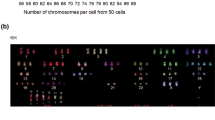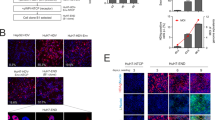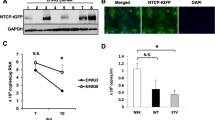Abstract
Hepatitis C virus (HCV) infection causes chronic liver disease and is a worldwide health problem. Despite ever-increasing demand for knowledge on viral replication and pathogenesis, detailed analysis has been hampered by a lack of efficient viral culture systems. We isolated HCV genotype 2a strain JFH-1 from a patient with fulminant hepatitis. This strain replicates efficiently in Huh7 cells. Efficient replication and secretion of recombinant viral particles can be obtained in cell culture by transfection of in vitro–transcribed full-length JFH-1 RNA into Huh7 cells. JFH-1 virus generated in cell culture is infectious for both naive Huh7 cells and chimpanzees. The efficiency of viral production and infectivity of generated virus is substantially improved with permissive cell lines. This protocol describes how to use this system, which provides a powerful tool for studying viral life cycle and for the construction of antiviral strategies and the development of effective vaccines. Viral particles can be obtained in 12 days with this protocol.
This is a preview of subscription content, access via your institution
Access options
Subscribe to this journal
Receive 12 print issues and online access
$259.00 per year
only $21.58 per issue
Buy this article
- Purchase on Springer Link
- Instant access to full article PDF
Prices may be subject to local taxes which are calculated during checkout




Similar content being viewed by others
References
Kato, T. et al. Sequence analysis of hepatitis C virus isolated from a fulminant hepatitis patient. J. Med. Virol. 64, 334–339 (2001).
Kato, T. et al. Efficient replication of the genotype 2a hepatitis C virus subgenomic replicon. Gastroenterology 125, 1808–1817 (2003).
Wakita, T. et al. Production of infectious hepatitis C virus in tissue culture from a cloned viral genome. Nat. Med. 11, 791–796 (2005).
Zhong, J. et al. Robust hepatitis C virus infection in vitro. Proc. Natl. Acad. Sci. USA 102, 9294–9299 (2005).
Date, T. et al. Genotype 2a hepatitis C virus subgenomic replicon can replicate in HepG2 and IMY-N9 cells. J. Biol. Chem. 279, 22371–22376 (2004).
Kato, T. et al. Nonhepatic cell lines HeLa and 293 support efficient replication of the hepatitis C virus genotype 2a subgenomic replicon. J. Virol. 79, 592–596 (2005).
Bukh, J. et al. Mutations that permit efficient replication of hepatitis C virus RNA in Huh-7 cells prevent productive replication in chimpanzees. Proc. Natl. Acad. Sci. USA 99, 14416–14421 (2002).
Lindenbach, B.D. et al. Complete replication of hepatitis C virus in cell culture. Science 309, 623–626 (2005).
Blight, K.J., McKeating, J.A. & Rice, C.M. Highly permissive cell lines for subgenomic and genomic hepatitis C virus RNA replication. J. Virol. 76, 13001–13014 (2002).
World Health Organization. Laboratory biosafety manual. 3rd edn. (World Health Organization, Geneva, Switzerland, 2004).
van den Hoff, M.J.B., Moorman, A.F.M. & Lamers, W.H. Electroporation in 'intracellular' buffer increases cell survival. Nucleic Acids Res. 20, 2902 (1992).
Takeuchi, T. et al. Real-time detection system for quantification of hepatitis C virus genome. Gastroenterology 116, 636–642 (1999).
Acknowledgements
Partially supported by a grant-in-aid for Scientific Research from the Japan Society for the Promotion of Science, from the Ministry of Health, Labour and Welfare of Japan and from the Ministry of Education, Culture, Sports, Science and Technology, and by the Research on Health Sciences Focusing on Drug Innovation from the Japan Health Sciences Foundation.
Author information
Authors and Affiliations
Corresponding author
Ethics declarations
Competing interests
The authors declare no competing financial interests.
Rights and permissions
About this article
Cite this article
Kato, T., Date, T., Murayama, A. et al. Cell culture and infection system for hepatitis C virus. Nat Protoc 1, 2334–2339 (2006). https://doi.org/10.1038/nprot.2006.395
Published:
Issue Date:
DOI: https://doi.org/10.1038/nprot.2006.395
This article is cited by
-
Cross talk between alcohol-induced oxidative stress and HCV replication
Archives of Microbiology (2020)
-
Impact of novel NS5A resistance-associated substitutions of hepatitis C virus detected in treatment-experienced patients
Scientific Reports (2019)
-
Combinations of two drugs among NS3/4A inhibitors, NS5B inhibitors and non-selective antiviral agents are effective for hepatitis C virus with NS5A-P32 deletion in humanized-liver mice
Journal of Gastroenterology (2019)
-
Lobohedleolide suppresses hepatitis C virus replication via JNK/c-Jun-C/EBP-mediated down-regulation of cyclooxygenase-2 expression
Scientific Reports (2018)
-
DCAF1 is involved in HCV replication through regulation of miR-122
Archives of Virology (2018)
Comments
By submitting a comment you agree to abide by our Terms and Community Guidelines. If you find something abusive or that does not comply with our terms or guidelines please flag it as inappropriate.



